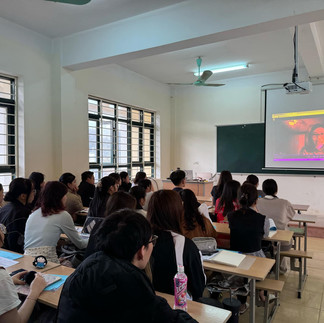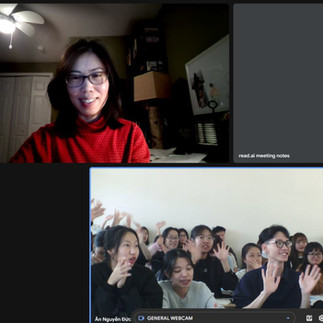Immigration, Multilingualism, and Education: Dr. Linh Phung’s Talk at Tây Bắc University
- Eduling

- Apr 18
- 3 min read
Updated: Apr 19
Dr. Linh Phung shares insights on U.S. immigration and multilingual education with students at Tây Bắc University, Vietnam

On April 14, 2025, students at Ms. Nguyễn Đức Ân's K63 class at Tây Bắc University participated in an engaging session with Dr. Linh Phung, an experienced educator, the creator of the Eduling Speak app, and former director of the English Language Program at Chatham University in Pittsburgh. Dr. Phung shared her personal journey from Vietnam to the United States and provided an overview of U.S. immigration history, multilingual education, and recent policy developments impacting English learners.
A Nation of Immigrants
Dr. Phung emphasized that the U.S. has always been shaped by immigration, starting with European settlers in the early 1600s. Over the centuries, the country has experienced various waves of immigration, along with legislation that shaped who could enter and settle. One key law, the Immigration Act of 1924, introduced strict quotas that limited immigration from many regions of the world. However, this policy was eventually repealed with the Immigration and Nationality Act of 1965, which abolished quotas based on national origin and led to a significant increase in immigration from Asia, Latin America, and other regions.
Today, about 13% of the U.S. population—more than 40 million people—are foreign-born. These immigrants contribute to the country’s rich cultural and linguistic diversity.
Language Diversity in the U.S.
Dr. Phung highlighted that the United States is home to speakers of many different languages. According to recent census data, approximately 70 million people speak a language other than English at home. The five commonly spoken languages after English are:
Spanish (about 42 million speakers),
Chinese (including Mandarin and Cantonese) (about 3.5 million speakers)
Tagalog (about 1.8 million speakers),
Vietnamese (about 1.6 million speakers), and
Arabic (about 1.3 million speakers).
She stressed the importance of viewing multilingualism as a strength in both society and education.
Multilingual Learners in Public Education
Dr. Phung explained that there are approximately five million multilingual learners—students who are still developing their English proficiency—in U.S. public schools.

These students are supported by several important laws and court decisions:
Title VI of the Civil Rights Act of 1964, which prohibits discrimination based on race, color, or national origin.
The Equal Educational Opportunities Act of 1974, which requires schools to take appropriate steps to overcome language barriers.
The Lau v. Nichols Supreme Court decision (1974), which affirmed that students who do not speak English well must be given adequate access to education.
These protections require schools to provide services such as English as a Second Language (ESL) programs and bilingual education to help students succeed.
Current Policy Challenges
Dr. Phung also addressed recent policy developments, including a March 2025 executive order declaring English as the official language of the U.S. She expressed concern that this move could reduce access to public services and education for multilingual individuals, even though schools are still legally required to provide language support.

She also noted staffing reductions at the Office of English Language Acquisition (OELA) and the Office for Civil Rights (OCR) within the U.S. Department of Education. Although Title III funding for English learner services has not been cut, the loss of staff may affect the government’s ability to support schools and enforce civil rights protections.
Using Technology to Support Language Learning
When asked about the Eduling Speak app, which she founded, Dr. Phung introduced it as a tool designed to help learners improve their English through conversation and task-based activities. She encouraged participants to explore the app and mentioned an upcoming virtual event connecting students from Vietnam, Japan, and the U.S.

Some more pictures at the events
Final Thoughts
Dr. Phung’s session offered students valuable insights into the intersection of immigration, education, and language policy in the United States. Her talk also underscored the importance of supporting multilingual learners and the potential of technology to bridge language and cultural gaps.
About Dr. Linh Phung: Dr. Linh Phung is a language educator, researcher, and creator with 20 years of experience in language education. She is the Founder of the Eduling Speak app, which offers specialized English courses based on communicative tasks and games. As an author, she has published four language learning books and three children's books. As a researcher, she has her research published in high impact journals. Her professional experience also involves working as the Director of the English Language Program at Chatham University for 12 years, serving as an English Language Specialist with the U.S. Department of State, working at Shorelight as a senior research analyst, and being Chief Learning Officer of Pangea Chat.
Some references:
https://www.census.gov/library/stories/2022/12/languages-we-speak-in-united-states.html
https://www.census.gov/newsroom/press-releases/2023/language-at-home-acs-5-year.html
https://nces.ed.gov/programs/coe/indicator/cgf/english-learners-in-public-schools
TESOL Advocacy Webinar: U.S. Federal Actions & Implications for the ELT Field & MLEs - 4 April 2025






















Comments